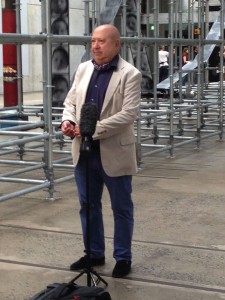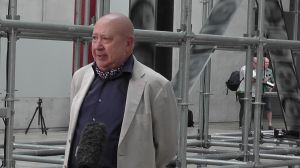Archive for January, 2014
Christian Boltanski eats live native green tree ants in Sydney
Jan 13th
What does a famous French artist do at a VIP dinner in his honour, when his dessert starts crawling around in the bowl?
If you are Christian Boltanski, you are highly amused, intrigued, say “non, non”, clap your hands to your face, and finally agree to have one popped into your mouth.
I snapped Boltanski at the dinner at Carriageworks in Sydney, as Parisian art consultant Eva Albarran encouraged him to try a live Australian native green tree ant.
Boltanski was in Sydney for the opening of his massive Carriageworks installation called Chance. Dinner was cooked in situ by Sydney star chef Kylie Kwong, who has started using indigenous foods in her cooking.
And Boltanski’s reaction to the citrus-like flavour of the live ants? “Pas mauvais” (not bad), the artist conceded.
Elizabeth Fortescue, January 13, 2014, Sydney

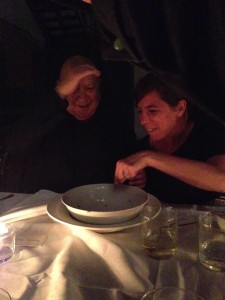
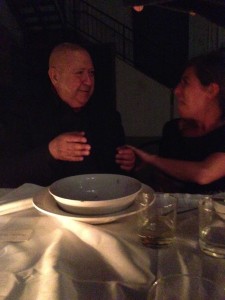
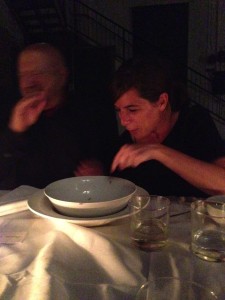

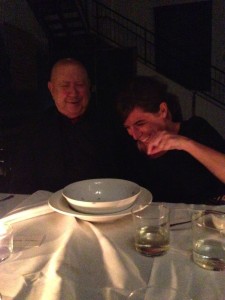
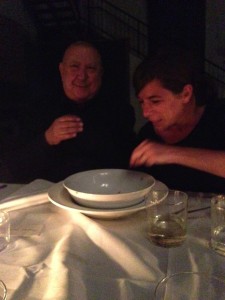
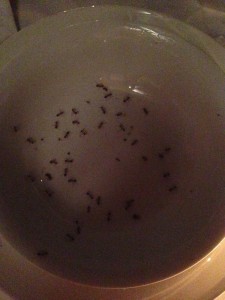
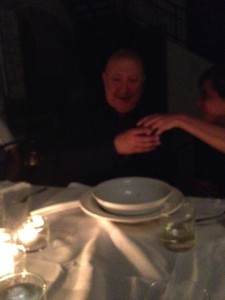
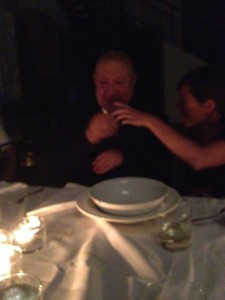
A Chance meeting with Christian Boltanski
Jan 9th
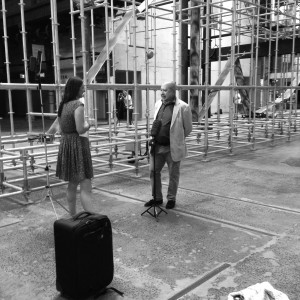 The renowned French artist Christian Boltanski is in Sydney for the opening at Carriageworks of Chance, his grand, post-industrial installation about birth and death. I met him there, on assignment for the Daily Telegraph, and will write about our interview lower in this story.
The renowned French artist Christian Boltanski is in Sydney for the opening at Carriageworks of Chance, his grand, post-industrial installation about birth and death. I met him there, on assignment for the Daily Telegraph, and will write about our interview lower in this story.
First, some background.
Boltanski already has a link to Australia, and has been here before. That occasion was to seal an unorthodox arrangement with David Walsh, founder of Tasmania’s Museum of Old and New Art (MONA) which has earned itself a reputation for showing art with a bit of shock value.
Boltanski and Walsh share an interest in chance. Walsh is a well known professional gambler as well as an art collector, while Boltanski has for many years created artworks which imply the random bestowal of good luck or bad luck by the vagaries of life. Boltanski, a Parisian, is fond of saying that if his mother and father had made love a minute earlier or later than they actually did, he would not have been born. Someone else would have been born instead. But because his parents made love at the exact moment they did, Boltanski was indeed born. Taking this one step further during the media preview of Chance in Sydney, Boltanski offered the philosophical position that his conception prevented the birth of potential others, and that he was therefore responsible for their non-existence. A fascinating thought.
Boltanski is evidently a man of good humour as well as labyrinthine philosophical ponderings. In 2010 he made an agreement with David Walsh in which the two men are, in essence, betting on how long Boltanski will live.
Here’s how it works. Boltanski agreed to set up several video cameras inside his Paris studio. Images of whatever is going on in the studio are live-streamed straight to Walsh, 24 hours a day. This includes when there is nothing going on in the studio, because Boltanski is in bed. The videos are stored on DVD, becoming an accumulating work whose title is simply The Life of C.B.
Boltanski said he sometimes remembers to wave hello at the cameras when he is in the studio, but mostly he just forgets the cameras are there.
For the right to film Boltanski in this way, Walsh pays the artist an undisclosed monthly sum. After eight years of payments, Walsh will have paid Boltanski the agreed purchase amount for The Life of C.B. If Boltanski dies before the eight years are up, Walsh will have got the work cheaply. But if Boltanski lives to be a centenarian, Walsh will have paid dearly – and he’ll own an awful lot of DVDs of Boltanski pottering more and more creakily around his studio.
Boltanski’s work, Chance (on view at Carriageworks from January 10, 2014 until March 23, 2014 as part of the Sydney Festival), can only be described as monumental. Comprising 16 tonnes of scaffolding and 600 portraits of new-born Polish babies, it resembles a rumbling, racing newspaper pressroom. The babies’s images form one long loop of film which cascades like a human torrent around the scaffolding.
A bell clangs every few minutes, heralding the cessation of the noisy machinery and randomly bringing one of the baby portraits into focus on a video screen. Having ceased for a few seconds, the giant mechanism begins to move once more, inspiring something of the awe one feels when watching a newspaper edition coming off the presses.
A large LED screen at either end of the installation records the estimated numbers of births and deaths being experienced globally that day. (Boltanski takes these statistics from the internet).
Another element of the work involves visitors stepping up to a small console on which they will find a button. On the wall in front of them they will find a video screen divided into three horizontal strips. Each strip shows a rapid-fire succession of the upper, middle and lower parts of the face. It somewhat resembles the parlour game called “exquisite corpse”. When the visitor presses the button, the images suddenly stop and form a face. There is a one in 1500 chance of matching all three elements and forming a real face, in which case you win a photograph of the face signed by Boltanski.
The idea of Chance is that the computer chooses an individual at random. “We don’t know if it’s for the good or the bad,” Boltanski said.
Boltanski declares himself to be “not a believer”, and in Chance he dwells on the random, capricious and hazardous nature of life.
You might expect Boltanski to be a pessimist. But he’s not. He is impish, friendly, chatty, welcoming and clearly enjoys life.
I asked him what personal life event had started him thinking about chance.
“At the beginning of a life of an artist there is a trauma. In my case it was more historical trauma,” Boltanski said.
The artist was born in Paris just two weeks after the 1944 liberation of the city from Nazi Occupation. His mother was a non-Jew and his father was a Jew. During the dark months of the Occupation, it was always a risk that the Nazis would storm the family home looking for Jews. Actually, they did just that.
“The police came and they didn’t find my father,” Boltanski said.
His parents decided the best way of survival was to divorce. This would enable the mother to explain the absence of a husband who, in reality, was hiding in a very tiny space within the family home. After the war, the couple remarried. It is a remarkable story, but one that Boltanski shrugs off.
“Everybody has this story,” he said.
Boltanski said it would have been completely understandable if his parents had decided to abort him, given the catastrophic circumstances of the Occupation.
“But they decided to keep me,” he says with a smile.
Boltanski believes Chance is a positive work of art. He calls it a “factory for babies”. Yes, we will die. But we will be replaced by a never-ending stream of brand new humans, he said.
I put it to Boltanski that it’s alright for him, because his art will live on after he dies. But he still seemed unconcerned.
“What’s important for me is more to ask questions,” he said.
“It’s very important in our society that we accept we are going to die and be older.”
The analogy he used was that an old farmer who dies is replaced in his duties by his son.
“It was important the farm went on,” Boltanski said.
As for his trip to Sydney, Boltanski has enjoyed a trip to Manly where he enjoyed the beach but did not swim.
Leaving Carriageworks, I suddenly wonder: If Boltanski had gone swimming, what are the chances he could have been taken by a shark?
Elizabeth Fortescue, January 9, 2014, Sydney
